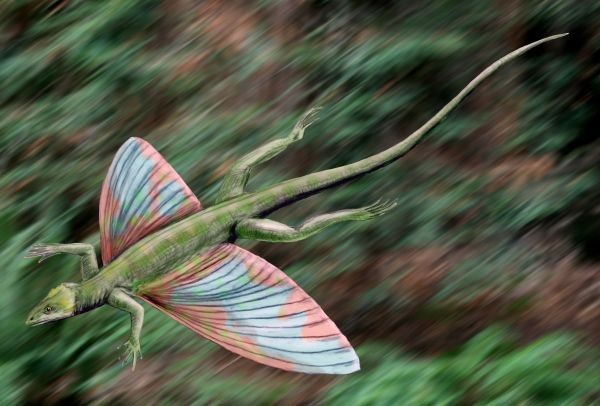Finally, enough fossils have been assembled by experts to show that the first reptile to glide resembled a dragon.
Researchers have used a fine-toothed comb to go through nearly perfect fossils of the first gliding reptile in the world and have untangled previously unknown facets to discover that a change in tree canopy most likely made it possible for these creatures to fly.
Coelurosauravus elivensis's unique body parts have been the subject of intense debate ever since the first fossils of the animal were found in 1907, raising questions about how the animal lived during the Late Permian Period, between 260 million and 252 million years ago, and how its unusual body parts fit together.

New research offers new insights into the tetrapod's habits and morphology, and crucially confirms how it's now the first-known reptile to glide by assembling enough fossils to create a nearly perfect skeletal reconstruction.
The answer to the latter question comes from the forest canopy where this unusual creature lived, according to experts from the Staatliches Museum für Naturkunde Karlsruhe in Germany as well as the Muséum National d'Histoire Naturelle in France and the French National Museum of Natural History in Paris.
Lead author Valentin Buffa from the Centre de Recherche en Paléontologie - Paris at the French Natural History Museum explains their findings in the peer-reviewed Journal of Vertebrate Paleontology, which was published today. He claims that while Pennsylvanian forests were taxonomically and vertically heterogeneous, they had relatively open canopy strata with spatially distributed arborescent taxa, resulting in little crown overlap.
Cisularian forests, in contrast, exhibit evidence of more saturated communities that point to more uninterrupted canopy strata. While several scansorial or arboreal amniotes have been described from Cisularian and Pennsylvanian deposits, there have been no glider reports before weigeltisaurids. This change in forest structure may be the cause.
Dragons
These dragons were not even forged in mythological fire, according to the research; rather, they just needed a way to travel. Gliding proved to be the most effective form of transportation. Their latest study demonstrates how their morphology made this possible.
Related fossils were examined by the team, including C. elivensis and several other specimens that are related to it, all of which are members of the Weigeltisauridae family. The body's postcranial region, which includes the limbs, torso, and remarkable patagium glider, was the focus of their study. In living creatures like sugar gliders, flying squirrels, and colugos, the latter is a membranous flap that spans the forelimbs and hindlimbs.
As in the modern Draco species of Southeast Asia, which continues to astound onlookers with its gliding flights from one rainforest tree to another one that it inhabits, earlier research on the reptile had presumed that its patagium was supported by a skeletal system that extended from the ribs.
Gliding Reptiles
But this exhaustive new investigation hints that the patagium of C. elivensis either came from the trunk's musculature or the gastralia, which are a group of bones in some reptiles' skin covering their bellies, such as crocodilians and dinosaurs. Accordingly, the gliding mechanism would have rested lower on the abdomen area than it does in contemporary gliding lizards.
The scientists developed a more detailed theory of how this agile animal moved throughout its arboreal habitat by combining this discovery with others obtained from the bone structure seen in the fossils.
Buffa added that the idea that the creature was perfectly adapted to easily move vertically up tree trunks is supported by sharp, curved claws and compressed body form. The forelimbs' proportional length helped the animal stay close to the surface of trees, preventing it from suddenly pitching and eventually losing its balance. This is another sign that it was an experienced climber.
This interpretation is further supported by its long, slender body and whip-like tail, which are also present in modern arboreal reptiles.
Buffa says that C. elivensis does strikingly resemble the modern genus Draco. Although its habits were probably similar to that of its modern equivalent, there are a few small differences.
Buffa also pointed out that Coelurosauravus, like Draco lizards, was able to stabilize its patagium during flight and even adjust it, giving it greater maneuverability. However, this ability might have been improved by an additional finger joint. This might have been a necessary adjustment for the patagium's lower positioning, which probably made it more unstable, Science Daily reports.
Related article : Special Lizard-Like Fossil Older than Most Dinosaurs May Explain the Origin of Lizards
© 2026 NatureWorldNews.com All rights reserved. Do not reproduce without permission.





